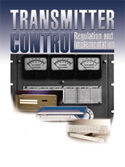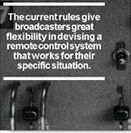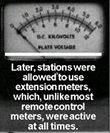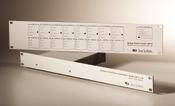
WMRA Homepage
Technical Info on WMRA website
Photo Tour
Site Info & Coverage
The LINKY page

Transmitter Control
I’d like to see a show of hands: How many of you have ever had the Commission call you and request an immediate shutdown of your facilities? I thought so.
By William Fawcett
 In spite of its rarity (has it ever occurred?), the entire premise of the existing rules on transmitter control are based on this implausible scenario. Not that anyone’s complaining; but the current rules on transmitter control are by far the most lenient in the history of broadcasting. We have come a long way from 30-minute logging intervals and daily inspections. Technology has come a long way as well. About the only thing that hasn’t come a long way is clarity in the FCC rules regarding transmitter control.
In spite of its rarity (has it ever occurred?), the entire premise of the existing rules on transmitter control are based on this implausible scenario. Not that anyone’s complaining; but the current rules on transmitter control are by far the most lenient in the history of broadcasting. We have come a long way from 30-minute logging intervals and daily inspections. Technology has come a long way as well. About the only thing that hasn’t come a long way is clarity in the FCC rules regarding transmitter control.
Not only is equipment much more stable than before, but the technological advances in computing have allowed many of the simple monitoring and control functions to be delegated to a microprocessor. Although still not too receptive to lightning hits, computer chips are seldom late for work, and rarely arrive with a hangover, so overall the switch to automated controls has been a net improvement.
These technologies encouraged the FCC to first accept the concept of Automatic Transmission Systems (ATS) in 1977. Early units were amazing combinations of instrumentation amplifiers and motor driven rheostats. As microprocessors became common, these too were placed into service.
The array of equipment available today ranges from extension meters and simple stand-alone dial-up systems to web-cams and Ethernet-integrated systems capable of 256-site control. Regardless of the technology employed, there are several basic concepts that must be considered
Attended vs. unattended operation
A station may operate attended, unattended, or a combination of the two.
The FCC self inspection checklist states, “Attended operation consists
of ongoing supervision of the transmission facilities by a station employee
or other person designated by the licensee either at the transmitter site,
a remote control point, or an ATS control point. Such supervision may
be by direct observation and control of the transmitting system by a live
person at the transmitter site or remote control point, or such supervision
can be by automated equipment that is configured to contact a person designated
by the licensee. In either case a live person must be on duty at a fixed
location during all hours of broadcast operation where he or she can turn
off the transmitter and can either monitor the station
operating parameters or be contacted by the automated equipment that is
monitoring the equipment. During attended operation, it is expected that
the transmitter will be turned off by station personnel within three hours
of an overpower or overmodulation condition that can cause interference
that cannot be corrected within that period of time.”1
On the other hand, the FCC states, “Unattended operation consists
of using self-monitoring or automatic transmission system (ATS) monitoring
equipment to control the transmission system, or alternatively, operation
in the absence of constant human supervision with equipment that can operate
for prolonged periods of time within assigned tolerances. In the former
case, equipment must be configured to automatically take the station off
the air within the required three-hour or three-minute (certain AM DA
requirements) time periods after an out-of-tolerance condition arises.
In the latter case, the licensee is required to make certain that the
station is monitored frequently enough to ensure that station operation
is corrected or terminated within the designated 3-hour time limit, but
constant human supervision is not required.” 2
 The
Commission has been emphatic in stating that the rules permit unattended
operation of the transmitter, but do not relieve the station of the staffing
requirements of the main studio. Stated generally, for part 73 broadcasters,
the main studio must be staffed by two full-time employees. Note that
the FCC does not “require the main studio staff to monitor an unattended
broadcast transmitter.”
3
The
Commission has been emphatic in stating that the rules permit unattended
operation of the transmitter, but do not relieve the station of the staffing
requirements of the main studio. Stated generally, for part 73 broadcasters,
the main studio must be staffed by two full-time employees. Note that
the FCC does not “require the main studio staff to monitor an unattended
broadcast transmitter.”
3
Section 73.1350(b)(2) states that “transmitter control personnel
must have the capability to turn the transmitter off at all times. If
personnel are at a remote location, the control system must provide this
capability continuously or must include an alternate method of acquiring
control ...that operation [may] be terminated within 3 minutes.”4
The problem with this rule is that it does not seem to directly address
the situation where the station is operating unattended, that is with
no control personnel.
Monitoring
and Control Systems
The broadcaster may choose among many differing schemes for transmitter
control, which may be broken down into three major categories.
 Local
control, of course, is the simplest option. In the good old days, the
transmitter meters had to be visible from the control point. This is why
many studios had a transmitter in an adjacent room with a window. Some
stations employed mirrors or TV cameras to meet this requirement. Later,
stations were allowed to use extension meters, which, unlike most remote
control meters, were active at all times. Under these rules the transmitter
was required to be within 100 feet of the control point.
Local
control, of course, is the simplest option. In the good old days, the
transmitter meters had to be visible from the control point. This is why
many studios had a transmitter in an adjacent room with a window. Some
stations employed mirrors or TV cameras to meet this requirement. Later,
stations were allowed to use extension meters, which, unlike most remote
control meters, were active at all times. Under these rules the transmitter
was required to be within 100 feet of the control point.
Remote control allows the location of the control point (typically the
main studio) away from the transmitter site. The rules state that “The
remote control system must provide sufficient transmission system monitoring
and control capability so as to ensure compliance with Section 73.1350”.5
 ATS
involves the use of monitoring systems that will contact an operator should
an ongoing out-of-tolerance condition occur. If the condition is not corrected
within a given time span, the equipment will shut down the transmitter.
Many remote control systems may be configured for ATS operation. The FCC
will allow a hybrid ATS/remote control-type system.
ATS
involves the use of monitoring systems that will contact an operator should
an ongoing out-of-tolerance condition occur. If the condition is not corrected
within a given time span, the equipment will shut down the transmitter.
Many remote control systems may be configured for ATS operation. The FCC
will allow a hybrid ATS/remote control-type system.
A fourth option is no monitoring whatsoever. The FCC allows the use of
“equipment that can operate for prolonged periods of time within
assigned tolerances.” This option still requires periodic verification
and the ability to shut down the equipment within the prescribed three-minute
limit. Obviously, the broadcaster who chooses this optionwould not have
a leg to stand on should the FCC detect an out-of-tolerance condition.
Telemetry and
Control Links
A multitude of options are available here, too. For control from a fixed
point, stations often employ part 74 frequencies, FM subcarriers or subaudible
tones on AM. Recently, 2.4GHz unlicensed spread-spectrum devices have
become popular. Stations that employ return links that piggyback on the
broadcast signal are at a considerable disadvantage when the station goes
off the air. Dial-up control systems are popular, especially since they
allow the use of floating control points and give the chief engineer direct
access to the transmitter from any phone.
 |
 |
| Telephones
access and control have become common in many systems. Some systems
utililize different access and control methods than their traditional
counterparts. |
The use of dial-up
control has been subject to controversy for many years. Finally, in the
last revision to the remote control rules6, the FCC allowed that the public
switched telephone network (PSTN) was reliable enough to replace dedicated
full-time leased lines. However, the rules require that the phone line
at the transmitter site be dedicated to that purpose. The problem relates
to the requirement that stations be able to shut down within three minutes
of a request by the FCC. If the station engineer has dialed in to check
meter readings, the station’s control point operator cannot access
the remote control because the phone is busy. Therefore, if the phone
line is not dedicated, an alternate method of transmitter shutdown must
be devised. This could involve a second phone line at the transmitter
site, or an audio fail-safe (2.5-minute time out), or an alternate signaling
method. A very common (and reliable) method is to loop the transmitter
interlock line through your STL receiver’s squelch relay. One FCC
staffer implied that a “well aimed cannon” 7
would also meet this secondary fail-safe requirement, however this method
is generally not acceptable to most zoning authorities.
It seems that when the FCC relaxes the Rules on an issue, some want to
push things even further. The FCC has allowed landline (PSTN) dial-up
control without backup shutdown capability under certain conditions. Not
all mountaintop transmitter sites have telephone lines available. Cellular
is an option, but do not confuse cellular with PSTN circuits. It is possible
to have a cellphone-controlled transmitter “leave the service area.”
Because of the unreliability of cellular systems (especially during peak
usage hours), I would suggest that any transmitter site that employs a
cellular-linked control system use some form of ATS so that long-term
(three hour) uncorrected conditions will trigger a shutdown. Furthermore,
such a system should have a secondary means of shutdown, such as a silence-sense
or STL squelch interlock. A station in Virginia has operated in accordance
with the rules using a system like this during prolonged (five day) cellular
outages.
If cellular is unreliable, how about the Internet? Think about how many
times you have been unable to access the FCC Daily Digest website before
pursuing this idea. While it might be an interesting experiment, a backup
remote control or an ATS with a secondary shutdown capability would probably
be necessary to ensure compliance.
Contact Person
The current rules give broadcasters great flexibility in devising a remote
control system that works for their specific situation. The consolidation
of broadcast facilities has brought forth a need for centralized control,
and this is now a possibility. The Rules do not allow a broadcaster to
simply lock the door to the station and go away — or do they? Some
small-market operators have declared their home as a secondary control
point, but are these operators really at that location at all times? What
if a station declares its operation unattended? It is not required to
have a control operator; therefore it is not required to have a control
point. Nonetheless, stations must meet the three-minute shutdown rule,
and it is implied that they must (through informal means 8)
have a record with the FCC of a contact person that can shut the station
down.
 |
| Access
via computer allows for increased monitoring capability and greatly
reduce systems setup time. |
Because of these ambiguities,
the SBE petitioned the FCC for a declaratory ruling in 1998, but nothing
has been forthcoming. For their own legal protection it would seem prudent
for stations operating in the unattended mode to at least supply a pager
or cell phone number to facilitate contact with the station during those
times.
A remote transmitter site with dial-up control is not required to have
a secondary shut-down means if a dedicated phone line is used. However,
A special waiver to that single-use phone line is permitted — the
phone may be used by the station engineer while he is at the site, with
the site under local control Of course, while the engineer is on the phone,
the FCC has no way to reach the station to ask it to shutdown. In fact,
there are sites that occasionally are operated under local control and
do not have a phone at all. It seems clear that inconsistencies in the
application of the three-minute rule leave all stations vulnerable to
problems should a station inspection occur.
The future
The NAB Guide to Unattended Station Operation has a comprehensive section
on the history of transmitter control regulation. This is a book that
should be on the required reading list of any station considering unattended
operation. It is interesting to see the progression of these rules through
the years. ATS rules, which were very specific, have been generalized
to the point where they have become hard to define. Certainly, anyone
with an ATS or remote control system operating unattended would do well
to simply declare it an unattended system based on stable operation using
ATS or remote control features to enhance the operation of that system.
This removes the higher obligations that are placed on those using an
ATS or remote control system. Indeed, some fully staffed stations without
ATS consider themselves operating unattended 24 hours a day.
This will practically set in place now what the FCC will inevitably do:
eliminate any equipment specifications and simply require stations to
operate within the prescribed limits. We saw this happen several years
ago when the requirement for a modulation monitor was eliminated —
now stations must simply stay within the FCC limits. Broadcasters need
this change, or at least a response to the SBE request, to eliminate the
confusion that these rules have spawned. There will always be stations
that want to skirt the rules, but responsible broadcasters should not
have to constantly wonder if they are meeting the letter of the law.
References
1 FCC
Bulletin EB-18FM, FM Broadcast Station Self-Inspection Checklist, January
2000 edition.
2.
ibid.
3.
ibid.
4. 47 CFR 73.1350(b)(2)
5.
47 CFR 73.1400(a)(3)
6.Report
and order FCC 95-412, released October 23, 1995.
7.
Harold Hallikainen quoting John Reiser, Insight on Rules #96, www.hallikainen.com/rw/insite/insite96.html
8 Report
and Order FCC 95-412, Paragraph 33, released October 23, 1995.
William Fawcett
is director of engineering at the Center for Public Broadcasting at James
Madison University and president of Mountain Valley Broadcast Service
in Harrisonburg, VA. Photo of the Gates remote control is from the collection
of Chuck Leavens.
© 2000, Intertec Publishing, A Primedia Company All Rights Reserved
Archives of these articles are maintained with permission of BE RADIO Intertec Publishing Corporation,
9800 Metcalf, Overland Park, KS 66212-2215. All articles(except updates) are copyrighted by
Intertec Publishing Corporation, permission to reprint articles may be obtained
from Chris Lotesto (312) 435-2359.

Contact Us 1-800-677-9672
Copyright © 2007 Commonwealth of Virginia
Questions or Comments on this Page |
Information Provider: WMRA
(4-25-2007)


 In spite of its rarity (has it ever occurred?), the entire premise of the existing rules on transmitter control are based on this implausible scenario. Not that anyone’s complaining; but the current rules on transmitter control are by far the most lenient in the history of broadcasting. We have come a long way from 30-minute logging intervals and daily inspections. Technology has come a long way as well. About the only thing that hasn’t come a long way is clarity in the FCC rules regarding transmitter control.
In spite of its rarity (has it ever occurred?), the entire premise of the existing rules on transmitter control are based on this implausible scenario. Not that anyone’s complaining; but the current rules on transmitter control are by far the most lenient in the history of broadcasting. We have come a long way from 30-minute logging intervals and daily inspections. Technology has come a long way as well. About the only thing that hasn’t come a long way is clarity in the FCC rules regarding transmitter control.
 The
Commission has been emphatic in stating that the rules permit unattended
operation of the transmitter, but do not relieve the station of the staffing
requirements of the main studio. Stated generally, for part 73 broadcasters,
the main studio must be staffed by two full-time employees. Note that
the FCC does not “require the main studio staff to monitor an unattended
broadcast transmitter.”
3
The
Commission has been emphatic in stating that the rules permit unattended
operation of the transmitter, but do not relieve the station of the staffing
requirements of the main studio. Stated generally, for part 73 broadcasters,
the main studio must be staffed by two full-time employees. Note that
the FCC does not “require the main studio staff to monitor an unattended
broadcast transmitter.”
3 Local
control, of course, is the simplest option. In the good old days, the
transmitter meters had to be visible from the control point. This is why
many studios had a transmitter in an adjacent room with a window. Some
stations employed mirrors or TV cameras to meet this requirement. Later,
stations were allowed to use extension meters, which, unlike most remote
control meters, were active at all times. Under these rules the transmitter
was required to be within 100 feet of the control point.
Local
control, of course, is the simplest option. In the good old days, the
transmitter meters had to be visible from the control point. This is why
many studios had a transmitter in an adjacent room with a window. Some
stations employed mirrors or TV cameras to meet this requirement. Later,
stations were allowed to use extension meters, which, unlike most remote
control meters, were active at all times. Under these rules the transmitter
was required to be within 100 feet of the control point. ATS
involves the use of monitoring systems that will contact an operator should
an ongoing out-of-tolerance condition occur. If the condition is not corrected
within a given time span, the equipment will shut down the transmitter.
Many remote control systems may be configured for ATS operation. The FCC
will allow a hybrid ATS/remote control-type system.
ATS
involves the use of monitoring systems that will contact an operator should
an ongoing out-of-tolerance condition occur. If the condition is not corrected
within a given time span, the equipment will shut down the transmitter.
Many remote control systems may be configured for ATS operation. The FCC
will allow a hybrid ATS/remote control-type system.

